teaching plan教案
A Teaching Plan一份教案设计

A Teaching PlanⅠ.T eaching Contents 教学内容这节课的教学内容是三年级上册的Lesson 17 的Just talk 和Just learn 部分Ⅱ. Teaching Demands 教学目标1.knowledge and skills 知识与技能会听,说,认读单词:leg knee foot会听和说句型:How are you? 你好吗?2.progress and methods 过程与方法我们可以通过听,说,读,角色扮演和游戏的方式来完成这一节课的教学内容。
3.emotions, attitude and values 情感,态度与价值观通过学习这一节课,我们要培养学生在日常生活的卫生保健意识,和注意人身安全Ⅲ.Important and Difficult Teaching Points 教学重难点这一节课的教学重难点是leg ,knee ,foot 这三个单词的读音Ⅳ. Teaching Aids 教学用具准备相关的教学图片和单词卡片Ⅴ. Teaching Procedures 教学过程StepⅠ.Warm-up热身1.Greeting 问候Good morning ,boys and girls .Good morning ,teacher . 2.大家一起唱Hello歌Hello,boys do oh do.Hello,girls do oh do.Hello,teacher do oh do.Hello, hello, hello .StepⅡ.Presentation 新课程现1..课件程现Let’s chant 的内容Leg, leg, how are you?How are you?Knee, knee, how are you ?How are you ?Foot , foot, how are you ?How are you ?I’m fine2.分组练习StepⅢ.Consolidation 巩固Let’s match腿脚膝盖foot leg kneeStepⅣ. Summary 小结本课我们学了几个关于身体部位的英语单词foot ,leg ,knee ,我们要把他们就记住了,会说他们。
(初二英语教案)八年级教案Teaching Plan L 3 B 2_八年级英语教案
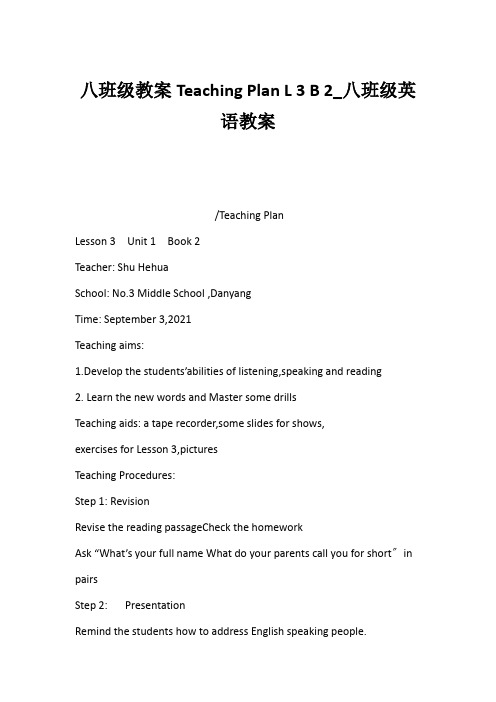
八班级教案Teaching Plan L 3 B 2_八班级英语教案/Teaching PlanLesson 3 Unit 1 Book 2Teacher: Shu HehuaSchool: No.3 Middle School ,DanyangTime: September 3,2021Teaching aims:1.Develop the students’abilities of listening,speaking and reading2. Learn the new words and Master some drillsTeaching aids: a tape recorder,some slides for shows,exercises for Lesson 3,picturesTeaching Procedures:Step 1: RevisionRevise the reading passageCheck the homeworkAsk “What’s your full name What do your parents call you for short〞in pairsStep 2: PresentationRemind the students how to address English speaking people.Write a name on the Bb: David William LewisFirst time: Pleased to meet you, Mr LewisGood friend: David / DaveRepeat with Catherine Mary JonesFirst time: Mrs JonesGood friends: David / DaveStep 3 : PracticePoint out the full and short forms of namesPractise a small dialogueStep 4 : Read and actAsk the question“Where is Sun Huifang from〞before playing the tape Read the dialogue then work in pairs, Act out the dialoguePoint out some phases1.How about/What about… 2 for short3.Where are you from=Where do you come from4.be short for5.know a lot about…6.only a littleStep 5: Ask and answerAsk and answer the questions in pairs about the pictureWhat and where are they doingMake sure the students are using the present continuous tenseStep 5: Exercises in class在以下各句空格处填入一个适当的词,使句子通顺、合理。
大班英语优质课教案《TeachingPlan》
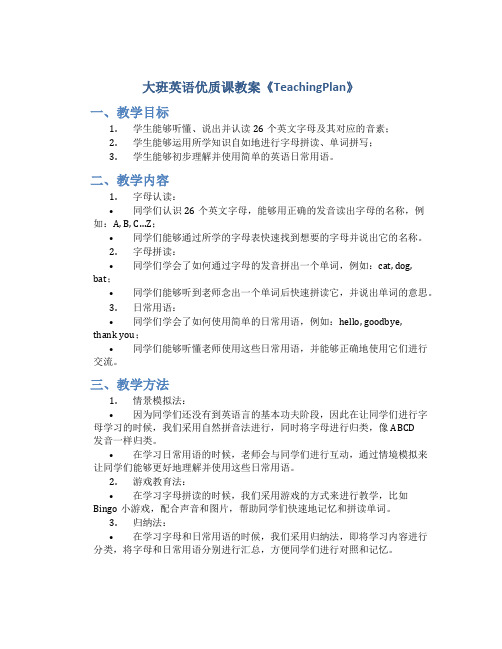
大班英语优质课教案《TeachingPlan》一、教学目标1.学生能够听懂、说出并认读26个英文字母及其对应的音素;2.学生能够运用所学知识自如地进行字母拼读、单词拼写;3.学生能够初步理解并使用简单的英语日常用语。
二、教学内容1.字母认读:•同学们认识26个英文字母,能够用正确的发音读出字母的名称,例如:A, B, C…Z;•同学们能够通过所学的字母表快速找到想要的字母并说出它的名称。
2.字母拼读:•同学们学会了如何通过字母的发音拼出一个单词,例如:cat, dog, bat;•同学们能够听到老师念出一个单词后快速拼读它,并说出单词的意思。
3.日常用语:•同学们学会了如何使用简单的日常用语,例如:hello, goodbye,thank you;•同学们能够听懂老师使用这些日常用语,并能够正确地使用它们进行交流。
三、教学方法1.情景模拟法:•因为同学们还没有到英语言的基本功夫阶段,因此在让同学们进行字母学习的时候,我们采用自然拼音法进行,同时将字母进行归类,像ABCD发音一样归类。
•在学习日常用语的时候,老师会与同学们进行互动,通过情境模拟来让同学们能够更好地理解并使用这些日常用语。
2.游戏教育法:•在学习字母拼读的时候,我们采用游戏的方式来进行教学,比如Bingo小游戏,配合声音和图片,帮助同学们快速地记忆和拼读单词。
3.归纳法:•在学习字母和日常用语的时候,我们采用归纳法,即将学习内容进行分类,将字母和日常用语分别进行汇总,方便同学们进行对照和记忆。
四、教学步骤1. 字母认读1.听老师读出26个英文字母的名称,同学们跟读;2.分组比赛,根据老师所说的字母名称,第一个跟读出来的小组获胜;3.学生自由读出由老师即兴出现的随意字母。
2. 字母拼读1.老师播放音频,让学生们听声音,说出音频中的每个单词中的字母;2.BINGO小游戏,根据音频快速拼读单词并标记;3.学生自己编写单词进行拼读及说出意思。
二年级英语Time (teaching plan) 教学教案
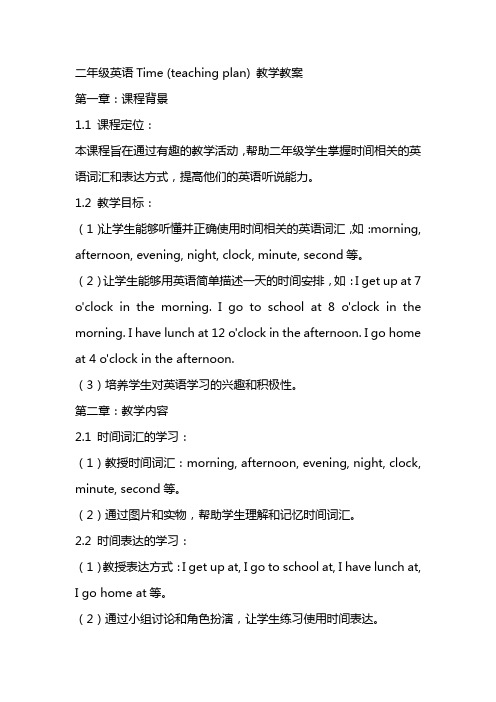
二年级英语Time (teaching plan) 教学教案第一章:课程背景1.1 课程定位:本课程旨在通过有趣的教学活动,帮助二年级学生掌握时间相关的英语词汇和表达方式,提高他们的英语听说能力。
1.2 教学目标:(1)让学生能够听懂并正确使用时间相关的英语词汇,如:morning, afternoon, evening, night, clock, minute, second等。
(2)让学生能够用英语简单描述一天的时间安排,如:I get up at 7 o'clock in the morning. I go to school at 8 o'clock in the morning. I have lunch at 12 o'clock in the afternoon. I go home at 4 o'clock in the afternoon.(3)培养学生对英语学习的兴趣和积极性。
第二章:教学内容2.1 时间词汇的学习:(1)教授时间词汇:morning, afternoon, evening, night, clock, minute, second等。
(2)通过图片和实物,帮助学生理解和记忆时间词汇。
2.2 时间表达的学习:(1)教授表达方式:I get up at, I go to school at, I have lunch at, I go home at等。
(2)通过小组讨论和角色扮演,让学生练习使用时间表达。
第三章:教学方法3.1 游戏教学法:通过趣味游戏,让学生在轻松愉快的氛围中学习时间词汇和表达。
3.2 情境教学法:创设真实的生活情境,让学生在实际语境中练习使用时间表达。
3.3 小组合作学习:引导学生分组讨论和角色扮演,提高学生的参与度和合作意识。
第四章:教学步骤4.1 热身活动(5分钟):通过播放英文歌曲《Hello, Hello, Hello!》,让学生活跃气氛,进入学习状态。
高中英语教案(英文模板)Teachingplan
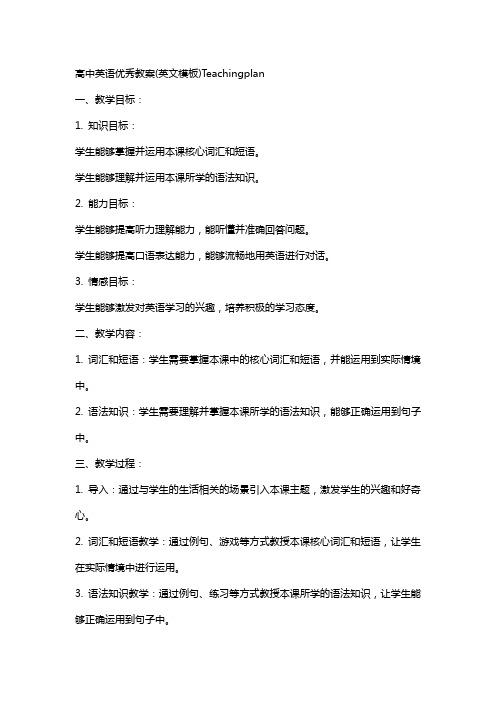
高中英语优秀教案(英文模板)Teachingplan一、教学目标:1. 知识目标:学生能够掌握并运用本课核心词汇和短语。
学生能够理解并运用本课所学的语法知识。
2. 能力目标:学生能够提高听力理解能力,能听懂并准确回答问题。
学生能够提高口语表达能力,能够流畅地用英语进行对话。
3. 情感目标:学生能够激发对英语学习的兴趣,培养积极的学习态度。
二、教学内容:1. 词汇和短语:学生需要掌握本课中的核心词汇和短语,并能运用到实际情境中。
2. 语法知识:学生需要理解并掌握本课所学的语法知识,能够正确运用到句子中。
三、教学过程:1. 导入:通过与学生的生活相关的场景引入本课主题,激发学生的兴趣和好奇心。
2. 词汇和短语教学:通过例句、游戏等方式教授本课核心词汇和短语,让学生在实际情境中进行运用。
3. 语法知识教学:通过例句、练习等方式教授本课所学的语法知识,让学生能够正确运用到句子中。
四、作业布置:1. 词汇和短语练习:让学生完成相关的词汇和短语练习题,巩固所学知识。
2. 口语作业:让学生与同学进行对话练习,提高口语表达能力。
五、教学评价:1. 课堂参与度:观察学生在课堂上的积极参与程度和表现。
2. 作业完成情况:检查学生完成作业的情况,巩固所学知识。
3. 口语表达能力的提高:通过对话练习,评估学生的口语表达能力是否有提高。
六、教学策略:1. 任务型教学法:通过设计各种真实的任务,让学生在完成任务的过程中运用所学知识,提高语言运用能力。
2. 交际式教学法:鼓励学生积极参与课堂对话,培养学生的交际能力和团队合作精神。
3. 情境教学法:创设各种真实的学习情境,让学生在实际情境中感知和运用语言。
七、教学资源:1. 教材:使用符合课程标准的高中英语教材,为学生提供丰富的学习内容。
2. 多媒体设备:利用多媒体课件、视频等资源,丰富教学手段,提高学生的学习兴趣。
3. 网络资源:利用网络资源,为学生提供更多的学习资料和实践平台。
二年级英语Time (teaching plan) 教学教案
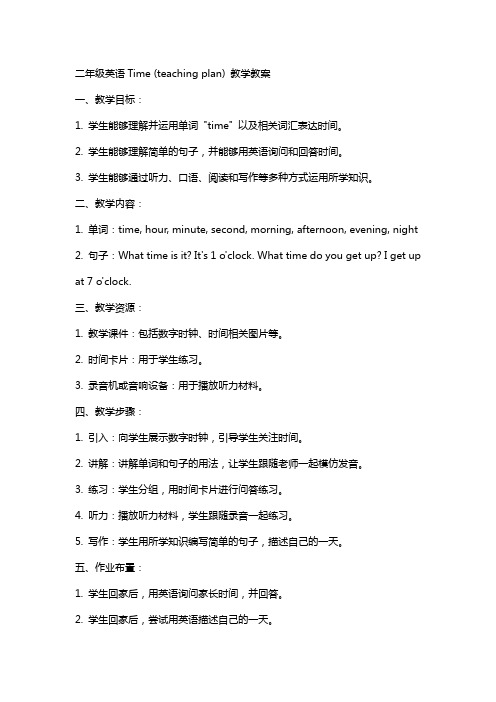
二年级英语Time (teaching plan) 教学教案一、教学目标:1. 学生能够理解并运用单词"time" 以及相关词汇表达时间。
2. 学生能够理解简单的句子,并能够用英语询问和回答时间。
3. 学生能够通过听力、口语、阅读和写作等多种方式运用所学知识。
二、教学内容:1. 单词:time, hour, minute, second, morning, afternoon, evening, night2. 句子:What time is it? It's 1 o'clock. What time do you get up? I get up at 7 o'clock.三、教学资源:1. 教学课件:包括数字时钟、时间相关图片等。
2. 时间卡片:用于学生练习。
3. 录音机或音响设备:用于播放听力材料。
四、教学步骤:1. 引入:向学生展示数字时钟,引导学生关注时间。
2. 讲解:讲解单词和句子的用法,让学生跟随老师一起模仿发音。
3. 练习:学生分组,用时间卡片进行问答练习。
4. 听力:播放听力材料,学生跟随录音一起练习。
5. 写作:学生用所学知识编写简单的句子,描述自己的一天。
五、作业布置:1. 学生回家后,用英语询问家长时间,并回答。
2. 学生回家后,尝试用英语描述自己的一天。
六、教学评估:1. 课堂参与度:观察学生在课堂活动中的参与情况,是否积极回答问题、参与小组讨论等。
2. 问答练习:评估学生在时间卡片问答练习中的表现,是否能够正确使用单词和句子表达时间。
3. 听力理解:通过听力练习,评估学生对时间相关句子的理解程度。
4. 写作作业:评估学生回家后完成的写作作业,是否能够用所学知识描述自己的一天。
七、差异化教学策略:1. 对于学习困难的学生,可以通过重复练习、个别辅导等方式帮助他们巩固知识点。
2. 对于学习进步的学生,可以提供更多的挑战性任务,如制作时间相关的思维导图、编写小故事等。
新职业英语《综合英语2》教案Unit 1 Teaching Plan

English for Careers 2Unit 1 WorkplaceAfter studying this unit, the students are able to master the key words and structures, and more importantly, to communicate for the following purposes:understanding workplace fashion trendsunderstanding a code of conduct (of a workplace)having internal communicationunderstanding and writing a noticepreparing for a partymastering time management•S s read Warming-up Task 1.•G et Ss to look at the layout of the office.•A sk Ss to identify different rooms.•G ive the suggested answers.Suggested answers:B—4 C—5 D—3 E—6 F—2 G—7Task 2 10 minutes Objective: Ss can give directions.Steps:•Ss read Warming-up Task 2.•Get Ss to look at the picture of Task 1.•Ask Ss to work in pairs and tell each other how to find Mike and Jack in the office.•Ask some Ss to report in class.•Give the suggested answers.Suggested answers:Go through the reception room to the hallway. The first room on your left is the multifunction meeting room. Mike is having a meeting there. Keep going straight along the hallway till you get to the end of it. Jack is working in the last staff office on your left.Paragraph 1fit in with:to live, work, etc. in an easy and natural way with someone/somethinge.g. H e’s never done this type of work before; I’m not sure how he’ll fit inwith the other people.Our national policy fits in with the changed international situation. reputation: n. the opinion that people have about whatsomeone/something is like, based on what has happened in the past e.g. T he school has a good reputation for examination results.He earned the reputation of being a hard worker.Paragraph 2pros and cons:the advantages and disadvantages of somethinge.g. W hat comment do you have on the pros and cons of studying abroad?We weighed up the pros and cons of starting up our own business. outfit:n. a set of clothes, especially one that you wear for a special occasion e.g. S he was dressed in a white outfit.On the opening ceremony of the sports meet, all of us wore sportsoutfits.The football team members were wearing orange outfits. compliment:n. a remark that shows you admire someone/somethinge.g. T hank you very much for your compliment.He knew that he had just been paid a great compliment.She took his acceptance as a great compliment.Paragraph 3for instance:for examplee.g. W hat would you do, for instance, if you found a member of staffstealing?His spelling is terrible. For instance, look at this word!For instance, an electric fire is a relatively expensive method of heating a room.casual:a. informale.g. H e was wearing casual clothes, not his school ones.We don’t like his casual behavior.Paragraph 4setting: n. a set of surroundings; the place at which something happense.g. I t was the perfect setting for a wonderful Christmas.People tend to behave differently in different social settings.The old castle would have provided the perfect setting for a horrorstory.productive:a. producing or achieving a lote.g. A griculture and industry both grow more productive.There are a lot of productive workers in this factory.Paragraph 6incorporate: v. to include something so that it forms a part of somethingelsee.g. M any of your suggestions have been incorporated into the plan.We have incorporated all the latest safety features into the design.His picture had been incorporated without his permission into anadvertisement.Task 1 5 minutes Objective:Ss can understand the passage and write the correct order. Steps:• Ss do Task 1.• Ask Ss to work individually.• Check the answers.Suggested Answers:1. C2. D3. B4. F5. E6. ATask 2 5 minutes Objective:Ss can decide whether the following statements are true or falseaccording to the passage.Steps:• Ss do Task 2.• Ask Ss to work individually.• Check the answers.Suggested Answers:1. F2. F3. F4. F5. TLanguage lab 45 minutesTask 1 5 minutes Objective:Ss know the spelling and meaning of the words and expressions from Reading A.Steps:• Ss read Task 1.• Allow Ss 5 minutes to do the task.• Check the answers.KeyKey: 1. J 2. I 3. F 4. H 5. B 6. G 7. D 8. E 9. A 10.CTask 2 10 minutes Objective:Ss can use the words and expressions from Reading A.Steps:Objective:Ss can accurately write down the missing information.Script:W: Roy, I shall work out a time to meet with your people to discuss the new project.M: Do you wish everyone in the department to be there? Wilson is on vacation this week.W: It would be best if everybody could be there. When will Wilson come back?M: Next Monday.W: How about sometime next week?M: Let m e look at the schedule first. I’ll get back to you this afternoon. W: Thank you.KeyKey:1. the new project2. on vacation3. next Monday4. the scheduleTask 2 10 minutes Objective:Ss can decide whether the statements are true or false. Script:M: Hi, Shelly, how are you today?W: Well, I didn’t sleep very well last night. I’m having a slight headache now.M: I’m sorry to hear that. Hope you’ll be better soon.W: Thanks. Do you know that a shift-work system is to be introduced next month?M: Really? How will we be affected?W: The system will affect everyone in our office. It will be on a two-shift basis—7 a.m. to 2 p.m., and 2 p.m. to 9 p.m.M: I wonder which shift I’ll be working on.W: Why don’t we go and ask the manager?M: I shall wait. Actually it doesn’t make any difference which shift I am allocated.Key:1. T2. F3. T4. FTask 3 10 minutes Objective: Ss can accurately tick off the items according to the conversation. Script:W: What do you usually wear for work?M: I don’t need to meet customers too often, so I usually wear very casual clothes in my office, like jeans and T-shirts. I feel more relaxed in that.W: What do you think of the dressing policies of a company?M: Well, I think formal business clothes should be worn when meeting with customers and clients at scheduled meetings. That gives people a sense of trust and authority.W: Yes. By looking neat and smart, we’ll be able to gain the trust of customers.M: Right. But at other times, staff can wear business casual clothes. This includes dress shirts, collared sports shirts, sweaters or skirts. But shoes should be formal. I suppose casual sandals and slippers are not suitable in the workplace.W: And I think blue jeans, T-shirts and shorts are far too casual to be accepted in the office.M: I don’t agree on this. I think casual wear brings a sense of freedom in the office and can inspire us in our job.W: Maybe you are right.KeyKey:Task 4 10 minutesObjective: Ss can understand the conversation and choose the best answer. Script:M: A report says that there has been too much water cooler chat in the company recently. I don’t think Mr. Blacksmith will be happy when he reads it.W: Well, the boss may not like it, but we do. It’s always relaxing to stay at the water cooler and chat for a while. It helps to ease the tension from the workload.M: Yes, I agree. But haven’t you noticed that some of our workmates are spending too much time chatting around the water cooler?W: You are right. I guess we need to come back to work once we finish our cup of coffee or tea.M: I don’t want our nice and pleasant water cooler chats to ever get the boss angry.W: Neither do I. I think the point is that we keep chatting at the water cooler until it is too long.M: Yes. Otherwise we might drink too much water and spend a lot of time in the bathroom!W: You bet!Q1: Who is Mr. Blacksmith?Fast reading 20 minutesObjective:Ss can comprehend Reading B.Steps:• Ss read the passage.• Provide help if needed.Task 1 10 minutesObjective:Ss can decide whether the following statements are true or false according to the passage.Steps:• Ss read the passage.• Ss complete the task.• Ss compare their work with others.• Select Ss to present their work.KeyKey: 1. F 2. F 3. T 4. F 5. FTask 2 10 minutesObjective:Ss can comprehend the specific information taken from the passage.Steps:• Ss read the passage.• Ss complete the task.• Ss compare their work with others.• Select Ss to present their work.Key:1. N2. N3. A4. N5. A6. NWriting 45 minutesTask 1 15 minutes Objective:Ss can get familiar with the style of notice.Steps:• Ss do the task individually.• Ss compare with each other’s answers.• Provide help if needed.• Present the answers.Key:NoticeKindly note that our Healthcare Center will be relocated to the following address with effect from September 1, 2009.New address: 909 J 2nd Street North,FultonNew YorkTelephone numbers and fax numbers remain unchanged.Thanks for your kind attention and continuous support.Task 2 15 minutes Objective:Ss can get familiar with the style of notice.Steps:• Ss do the task individually.• Ss compare with each other’s answers.• Provide help if needed.• Present the answers.Key:Sample:NoticePlease be informed that Office Safety Training Section will be conducted from 2:30 to 4:30 this Friday afternoon in Conference Room 109.All staff are required to come. Handouts will be available after the section.Jacky TamOfficeManagerJuly 15, 2009Task 3 15 minutesObjective:Ss can get familiar with the style of notice.Steps:• Ss do the task individually.• Ss compare with each other’s answers.• Provide help if needed.• Present the answers.Sample:NoticePlease be informed that a three-day sightseeing trip will be arranged for all the staff in our company.Time: May 28—May 30, 2010Destination: Guilin, Guangxi ProvinceItinerary: May 28 evening Train to Guilin, Guangxi ProvinceMay 29 morning City tour in GuilinMay 29 afternoon Cruise on Lijiang RiverMay 29 evening Free time in YangshuoMay 30 morning Train back。
授课教案 (Teaching plan)

授课教案(Teaching plan)培养目标作为现代高等教育的发端,天津大学在一百一十多年的办学实践中,秉承“实事求是”校训和“严谨治学、严格教学要求”的双严方针,牢固树立学校以育人为本、育人以教育为先、质量是学校的生命线、教学工作在学校具有优先地位的理念。
强化教学管理,深化教学改革,逐步构建了具有天大特色的本科创新人才培养体系。
努力培养专业口径宽、理论基础厚、实践能力强、综合素质高,具有创新精神和国际视野的高层次人才,使之成为推动科技创新、经济发展、社会进步的栋梁。
本课程是高等学校化学工程及工艺专业(本科)的一门专业基础课,是学生在具备了物理化学、化工原理、化工热力学等技术基础知识后的一门专业主干课。
本课程主要讲授化工生产实际中复杂物系的分级、分离、浓缩、提纯等技术。
通过该课程的学习,使学生掌握各种常用分离过程的基本理论,操作特点,简捷和严格计算方法以及强化改进操作的途径,并对一些新型分离技术有一定的了解,能够根据具体的分离任务和分离要求,选择适宜的分离方法,设计合理的分离序贯。
围绕本课程的实验教学、仿真实习、工程案例教学环节使分离理论与实践有机结合,显著增强了课程的工程实践特色,符合工科创新性人才的培养目标。
重点难点(1)课程的重点、难点化工分离过程属于理论性较强的课程,综合运用化工原理、物理化学、化工热力学、传递过程等课程的理论知识,针对化工生产中经常遇到的多组分非理想性物系,从分离过程的共性出发,讨论各种分离方法的特征。
本课程着重基本概念的理解,为分离过程的选择、特性分析和计算奠定基础。
在以基础知识、基本理论为重点的基础上,强调将工程与工艺相结合的观点,以及设计和分析能力的训练;强调理论联系实际,以提高解决实际问题的能力。
另外,在讲授传统分离技术的同时,还不断引进新型分离技术的有关内容,并逐渐加强其重要性,以拓宽学生在分离工程领域的知识面,从而适应多种专业化方向的要求。
难点在于本课程中应用到很多化工热力学和传递过程理论,内容较为深奥和抽象。
Teaching Plan教案
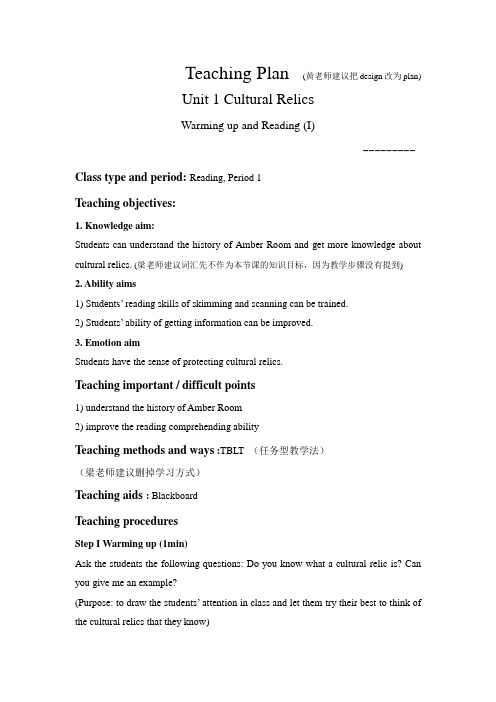
Teaching Plan (黄老师建议把design改为plan)Unit 1 Cultural RelicsWarming up and Reading (I)--------- Class type and period:Reading, Period 1Teaching objectives:1. Knowledge aim:Students can understand the history of Amber Room and get more knowledge about cultural relics. (梁老师建议词汇先不作为本节课的知识目标,因为教学步骤没有提到)2. Ability aims1) S tudents’ reading skills of skimming and scanning can be trained.2) Students’ ability of getting information can be improved.3. Emotion aimStudents have the sense of protecting cultural relics.Teaching important / difficult points1) understand the history of Amber Room2) improve the reading comprehending abilityTeaching methods and ways :TBLT (任务型教学法)(梁老师建议删掉学习方式)Teaching aids : BlackboardTeaching proceduresStep I Warming up (1min)Ask the students the following questions: Do you know what a cultural relic is? Can you give me an example?(Purpose: to draw the students’ attention in class and let them try their best to think of the cultural relics that they know)Step II Pre-reading (7mins)1.Ask the students to turn to page 2 of workbook and then name out the famous places in the pictures.2. Discuss what they are and whether they are cultural relics or not. And then think about the question2 and question3 on page1.3. Show them the definition of cultural relic.(Purpose: to raise students' awareness that there are some well-known cultural relics both at home and abroad. With the questions that they have thought about, students will have a clear idea of what a cultural relic is)Step III While-reading (25mins)(1)Fast readingAsk the students to read the text quickly and grasp the main idea of each paragraph. And then finish Exercise 2 on page 2. Match the questions with the paragraphs. (Purpose: to train students’ reading skill of skimming and make the students get the general idea of the text)(2)Careful reading1.Read the text carefully, try to get more detail information about the text, and finish Exercise 1, join the correct parts of the sentences together.(Purpose: to improve students’reading ability and make the students have a better understanding of the history of Amber Room)2. Read the text carefully again and answer the questions of Exercise 2 on page 2. (Purpose: to make the students read the text patiently and grasp the details of the text so as to deepen the understanding of this text.) (经思考觉得让学生回答练习2的五个问题比介绍琥珀屋这个填空题更有意义)Step IV Post-reading : Discussion (3mins)Ask the students to discuss the following questions with their partners.Do you think the Amber Room is a cultural relic? What is the value of the cultural relic?(Purpose: to make the students think actively and know the value of the cultural relicso as to have the awareness of protecting cultural relics.Step V Summary (2mins)Ask the students to retell what we have learned in this lesson.(Purpose:To make students have a clear memory of what they have learned)StepⅥHomework (1min)Read the text again and finish exercise 1of Discovering useful words and expressions. (Purpose: to make the students review the text and have a good preparation for next class)Blackboard design(经思考觉得不用板书词汇,右边留空写练习答案)Teaching reflection:。
unit III teaching plan
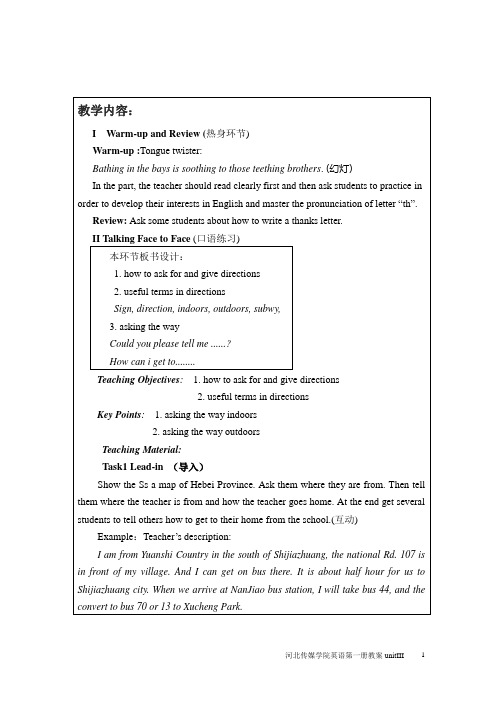
Play the tape of the dialogue for the Ss to listen and get them to point out the route on the map according to the dialogue. Then get the Ss to repeat how Mark gets to work. Play the tape again for the Ss to listen and follow. Go through the dialogue briefly and make sure the Ss understand it.
8. in the middle of 9. on the second floor 10. at the corner of 11. be opposite to 12 crossroads Task 4: Practice(互动环节,口语练习)
Show the Ss two maps. One is a street map and the other is A Map of a Building, the Fourth Floor. Explain the two maps. (备注:该环节教师引导学生应用 task 2, 3 中的关键词句,练习对话) NORTH STREET
河北传媒学院英语第一册教案 unitIII
1
Task 2
Data Bank(掌握) (掌握)
Tell the Ss It is important for us to know how to ask for and give directions. The following words and phrases and patterns will help us: Patterns (幻灯) 幻灯) Asking the way outdoors Inquiring 1. 2. 3. 4. 5. 6. Directing:1. 2. 3. 4. 5. 6. How do you usually get to work? How can I get to the railway station? Is there a railway station near there? Excuse me, Can you tell me where the station is? How far is it to the station? Which direction is it to the station? I live in an apartment on North Street. The museum is on Low Street. Go up / down / along street. Go straight on until you come to a crossroads. Take the first / second turning on your right / left. The station is on the corner / in front of you / to the south / at the
Teaching Plan(模板)精选全文

可编辑修改精选全文完整版Teaching PlanTeaching Content:Go for it, (students’ book of grade 9)Unit 1 How do you study for a test? (Section B, 3a, 3b, 3c.)Teaching Time: One class hour (40 minutes)Teaching Aims:1. Learn and master new words, phrases and sentence patterns.2. Enable the students to talk in English about how to study English very well.3. Develop the students reading and writing ability.Important Points:1. Master some phrases and the objective clause.2. Improve the students’ reading and writing ability on English learning skills.3. Learn to co-operate in the study with classmateTeaching Difficult Points:1. Phrases and Sentence Patterns:first of all, later on, laugh at, take notesSb. realize that – clause2.Improv e the students’ reading skills---skimming and scanning, locating the specificinformation.Teaching Methods:1. Task-based language teaching method.2. Question-and-answer activities to help the students to go through the whole passage.3. Individual, pair and group work to make every student work in class.Teaching Aids:The blackboardTeaching Procedures:Step 1 Greeting(1 min)Teacher uses different greeting expression to say “hello” with the students Step 2 Revision and lead-in(3 min)The teacher review the language points by asking the following questions:1.Can you speak English?2.How long have learned English?3.Are you enjoying learning English?4.Do you have good ways to study English well?Step 3 Presentation for reading(4 min)Students are asked to discuss with partner in 2 minutes and answer the question: Would you like to learn English well?Step 4 While-reading (25min)1. Fast reading(5 min)The students are given 2 minutes to read passage quickly. And then answer a question:How does she learn English well?The right answer will be repeated and written on the blackboard.2. Careful reading(10 min)After the teacher explain the main phrases “first of all, later on, laugh at, take notes”,and sentence patterns “ Sb. realize that – clause”, the students are given 4 minutes toread passage carefully again and do the exercises in pairs 3a, 3b,.The answer will be shared by the students in the group. And one representative willshare their group’s answer with the whole class.3. Practice(10 min)1) The teacher summarizes the good ways to learn English mentioned in the text..2) Divide students to groups to discuss how to become a better language learner.Then write a complete letter with about 50 words.Step 5 Post-reading(6 min)Make a competition: Invite the leader to read the complete letter.Step 6 Homework(1min)e the vocabulary learned in the class to write a short report on your own learning experience.2.Do a research on the good or helpful lessons on English learning.The Blackboard Design:Reflection:(It will be written just after class)。
Teaching-Plan-英语教案
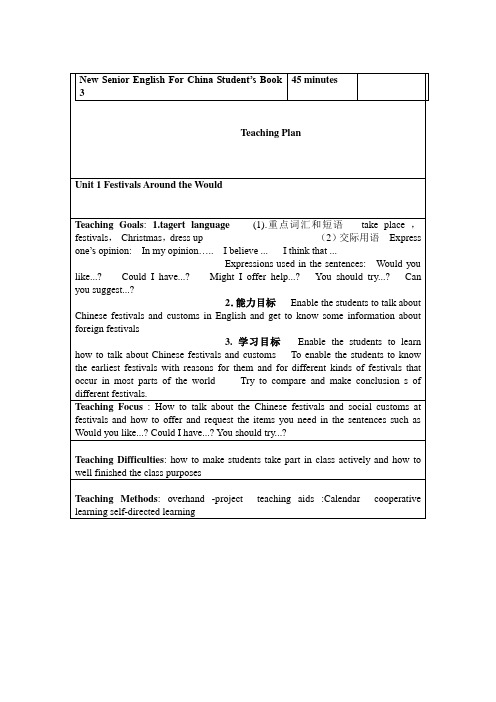
4 minutes
Now let’s see the home work please turn to page 5 do the excise 1,2 next class I will check your answers
Design of Blackboard
Unit 1 Festivals Around the Would
New Senior English ForChinaStudent’s Book 3
45 minutes
Teaching Plan
Unit 1 Festivals Around the Would
Teaching Goals:1.tagert language(1).重点词汇和短语take place,festivals,Christmas,dress up(2)交际用语Express one’s opinion: In my opinion….. I believe ... I think that ...
Sept 6
4 minutes
Now with you partner use these phrases to make sentences, ask students give their answers
Step7 give the summary
6 minutes
Now let’s give a summary what’s we are learnt today?
Expressions used in the sentences:
Festivals
Would you like…?
Mid-Autumn Day
CouldIhave….?
大班英语优质课教案《Teaching Plan》
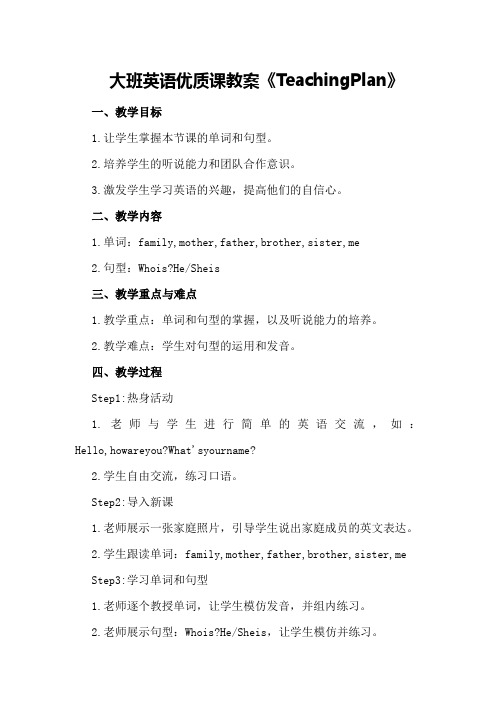
大班英语优质课教案《TeachingPlan》一、教学目标1.让学生掌握本节课的单词和句型。
2.培养学生的听说能力和团队合作意识。
3.激发学生学习英语的兴趣,提高他们的自信心。
二、教学内容1.单词:family,mother,father,brother,sister,me2.句型:Whois?He/Sheis三、教学重点与难点1.教学重点:单词和句型的掌握,以及听说能力的培养。
2.教学难点:学生对句型的运用和发音。
四、教学过程Step1:热身活动1.老师与学生进行简单的英语交流,如:Hello,howareyou?What'syourname?2.学生自由交流,练习口语。
Step2:导入新课1.老师展示一张家庭照片,引导学生说出家庭成员的英文表达。
2.学生跟读单词:family,mother,father,brother,sister,meStep3:学习单词和句型1.老师逐个教授单词,让学生模仿发音,并组内练习。
2.老师展示句型:Whois?He/Sheis,让学生模仿并练习。
3.学生两人一组,互相提问并回答。
Step4:小组活动1.老师将学生分成若干小组,每组选出一个组长。
2.每组根据所学单词和句型,编写一段对话。
3.各组进行展示,其他组认真倾听并给予评价。
Step5:游戏环节1.老师设计一个“猜猜看”游戏,让学生根据提示猜出家庭成员。
2.学生积极参与游戏,巩固所学知识。
1.老师邀请几名学生分享他们在本节课中的收获。
2.老师对学生的表现进行评价,给予鼓励和指导。
Step7:课后作业1.学生回家后,与家人一起用所学单词和句型进行交流。
2.家长监督并签字,确保孩子完成作业。
五、教学反思1.本节课通过多种形式的活动,让学生在轻松愉快的氛围中学习英语。
2.学生在小组活动中积极参与,提高了他们的团队合作意识和口语能力。
3.游戏环节让学生在游戏中巩固所学知识,提高了他们的学习兴趣。
4.课后作业的布置,有助于学生将所学知识运用到实际生活中。
英语活动教案《Sunny English》Teaching Plan

英语活动教案《Sunny English》Teaching Plan
《Sunny English》Teaching Plan
教学内容:学习英语日常口语
教学目标:
1.了解英语的基本语法和句型结构。
2.培养学生英语口语交流的能力。
3.提高学生对英语学习的兴趣和积极性。
教学准备:
PPT、录音机、卡片、英语教材、课件等教学资料
教学过程:
Step 1: Warm-up
1. 通过播放一段英文歌曲或唱英文歌曲,让学生进入英语的氛围。
2. 安排一些小游戏或互动,备课活动,为下一步教学做好准备。
Step 2: Introduction
1. 使用PPT或录音机,让学生听一些英语日常用语,并通过示意图或卡片等方式让学生理解这些单词的意思。
2. 介绍英语的基本语法,如主语、谓语、宾语等。
Step 3: Practice
1. 通过示范和练习,让学生学会描述和提出问题。
2. 课堂口语练习,让学生在销毁中使用英语进行对话。
Step 4: Homework
布置阅读和写作作业,如编写英语日记或阅读英语文章。
教学反思:
在教学过程中,我发现学生对于英语学习的兴趣和积极性得到了提高。
在课堂上,学生踊跃参与口语练习,充分发挥了英语口语交流的能力。
在下一节课前,我会继续加强学术成果的转化,增强学生的学习兴趣和主动性。
同时,我也会加强学生的口语练习,促进语言交流技巧的提升。
TeachingPlan(教案)(严燕玲)

Teaching PlanTalk Time----The studying of 8A important communicative expressions 听说课------ 广州版牛津8A课本重点交际用语的应用和学习初中部英语科严燕玲Analysis of Teaching Material (教学内容分析):Each unit has a part named Talk Time which requires students to learn and use the communicative expressions. Oxford English for 8 Grades (A) has five important Talk Time topic including (1)Giving opinions, agreeing and disagreeing;(2)Showing your concern; making accepting and refusing a suggestion; (3) Complaining and responding to complaints;(4) Making apologies and excuses; (5) Preferences and reasonsAnalysis of Students (学生分析):Students are in Grade 8. They are active.Teaching Objectives (教学目标)About knowledge: (知识目标)Students will be able to learn and review sentence patterns of 8A communicative expressions About ability: (能力目标)1. Students in groups are able to create a situation to apply the sentence patterns to practice.2. Students are able to use the language to do something.3. Students will be able to make assessments on others’performances according to the instructions.About attitude: (情感目标)1. Students are able to know the culture of western countries.2. Students can be more cooperative in groups.3. Students are able to appreciate others’ performances.Teaching Focus & Difficulties(教学重点与难点)1.While Students are watching the performances, they are doing the listening exercises.2.The summary of sentence patterns3. Peer -assessments.前置作业:8A 课本每一单元在speaking 里都有Talk Time 环节,其中从第三单元-第七单元,共五个单元都是英语交际用语的使用。
